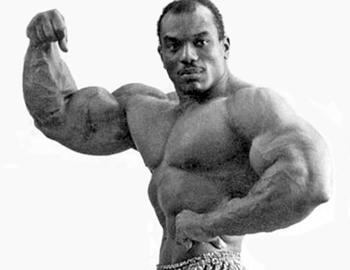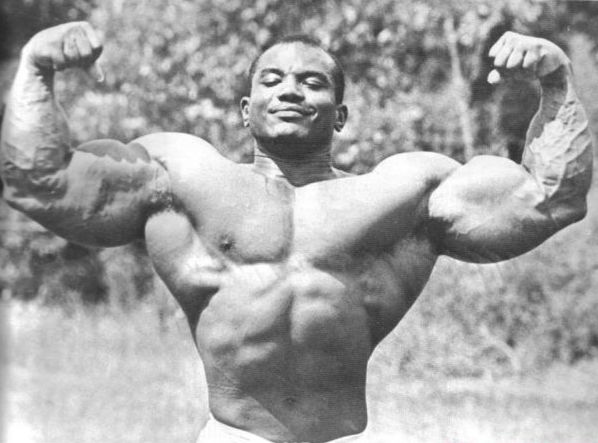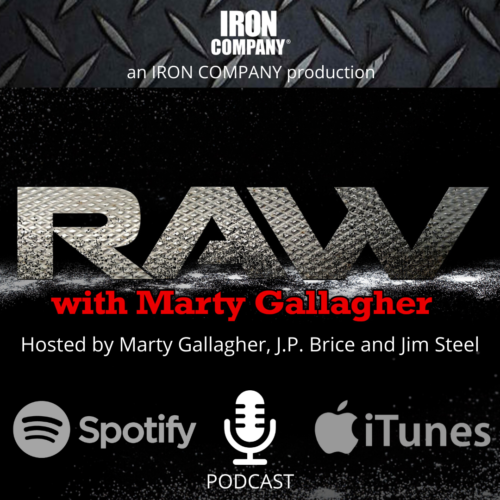
Building Big Arms, Old School Style
Big Arms - Sergio Oliva, circa 1969, the first man with arms bigger than his head: we were all envious
Confusion abounds in our modern era of too much information, especially when we seek to build big arms. It’s tough to drink from an informational firehose. Who knew there would be a downside to everyone knowing everything? How does one sort through the vastness of infinite possibilities? What modes and methods deliver the promised results? With everything polluted by commercialism, how does modern man separate the true and valuable from the fraudulent and incompetent?
One way to deal with confusion of the present is to look backwards in time to the clarity of the past. What were the modes and methods favored and used so effectively back in simpler times? If the goal is building big arms, back in simpler times of yore there was a lot of consensus and clarity insofar as arm-building.
One of the biggest myths in progressive resistance training is that a man can miraculously add 1-2 inches to their current arm size with no increase in bodyweight. This magical event occurs by finding the right arm exercise routine. The magical arm routine is out there – the trainee just hasn’t found it yet and needs to keep searching. As Derek Zoolander would say, “Earth to Hansel – there is NO such thing as the magical arm routine!”
Old School iron men learned the hard way, through collective empiricism, that, for an average size man, a ten-pound increase in lean muscle mass is required to add a genuine inch to current arm size. A hypothetical 160-pound man standing 5-foot 10-inches, a beginning bodybuilder, would need to push their bodyweight up ten pounds, to 170-pounds, in order to increase their flexed 14.5-inch arm to a true 15.5-inches.
That ten-pound increase in bodyweight need be mostly muscle, the increase in bodyweight cannot be 8-pounds of bodyfat (gained by living on pizza, beer, pastries and pastas) with only 2-pounds of muscle added. To add real arm size, a man must purposefully push up his lean muscle mass upward.
Adding bodyweight is a politically incorrect strategy for our delicate times. Every time I tell earnest trainees they need to add bodyweight to grow muscle, they look at me quizzically and kindly, as if I am mildly brain damaged, and afflicted with Tourette's syndrome, I have just blurted out something offensive and embarrassing.
To add quality size requires surplus calories. You do not grow big arms and larger muscles overall while dieting. Effective dieting requires we operate in a continual caloric deficit. This forces the body to use stored body fat as fuel. To construct new muscle tissue requires a caloric surplus. When enough surplus is accumulated anabolism is established. Anabolism is akin to fertility. When consistent anabolism is combined with intense and consistent resistance training, hypertrophy is triggered.

After an intense, effective, hypertrophy-inducing progressive resistance session, the trained muscle(s) is feed and rested. This completes the growth cycle. If the food/fuel used to attain anabolism is trash food, dirty calories, the athlete gains an unacceptable amount of body fat. Clean calories are the food/fuel of choice: quality protein, organic fat, fibrous carbohydrates, complex starch carbs. Precision nutrition is critical in ensuring any weight gain is lean muscle and not marbled with an unacceptable amount of body fat. Clean up the food sources: make better food (and drink) choices.
Old School iron men discovered that if during the mass-attaining phase, a preferential amount of training time was apportioned towards training a specific body part, that body part would reap a preferential and disproportional amount of the growth. Any subpar muscle or muscle group was “bought up” by using this coordinated approach: high calorie eating combined with specialization training, all designed to bring up a lagging muscle or body part.
In this protocol, two arm specialization workouts are done each week. Keep in mind that the triceps are worked extremely hard when bench pressing and again when performing overhead pressing doing shoulder work. One arm session is done after chest training. The second arm specialization session is done 2-3 days later, after training the shoulders.
Monday chest biceps/triceps
Tuesday legs
Wednesday cardio
Thursday shoulders biceps/triceps
Friday back, abs
Saturday cardio
Sunday cardio
Content should be varied: try and avoid doing the same exercise twice in a week. Perform a few warm-up sets before ripping into the all-out, top set. Work up to one all out set then move onto the next exercise. The final set in each exercise should be taken to one rep short of failure, or to positive failure, ideally ending in the 5-10 rep range.
In Bill Pearl’s exercise encyclopedia, Keys to the Inner Universe, 60 + distinctive types of curls and 50 + tricep exercises are identified. The only limit to arm training variety is your imagination and your access to tools and gym equipment. Here is one hypothetical arm specialization routine, doable for any trainee that belongs to the local YMCA.
Arm specialization - day 1
- Barbell cheat curl Arnold’s favorite: jolt to start, finish with slight lean-back
- Seated dumbbell curl sit up straight; no lean back, continuous tension
- Braced-arm curl preacher, spider, machine curl, pick one, super-strict
- Dips start weightless, when you can do 12 dips, add weight
- Overhead French press single dumbbell, sink behind the head, complete lockout
- Tricep press-down cable pushdown straight handles
Arm specialization - day 2
- Standing dumbbell curl use some lean-back at the top of the final reps
- Pole curls lean against a post or wall, no jerking or jolting
- EZ-curl bar curls strict and slow, continuous tension up and down
- Nose-breakers, EZ-curl bar lower with control, press to a hard lockout
- Double DB lying Tri press hammer curl grip, lower to shoulders, full lockout
- Rope-handle tri pushdowns exaggerated lockout, hold lockout until triceps cramp
You do not have to attempt a rep you know you have no chance of making. Having said that, going to failure, or just shy of it, is a relatively safe thing in arm training. There is no real danger of serious injury taking a cable pushdown or seated dumbbell curl to failure – a better question is, why not? Most top sets should stall out in the 5-10 range with 6-8 being the norm. To save time, feel free to super-set, alternate, biceps and triceps. Day one super-setted would look like this…
- Barbell cheat curl alternated with dips – rest – then
- Seated dumbbell curls alternated with overhead tricep press – rest – then finish with
- Preacher curls alternated with tricep cable pushdowns
Using the super set strategy slices arm training time in half, with no degradation in performance. Don’t rush the rest time between super-sets. Don’t inject a cardio element into a mass-building regimen for big arms, save the 30-second timed rest periods for the lean-out phase.
This type of training for big arms needs to be “under-pinned” with power eating. The only way to reap optimal big arms results is combine power training with power eating: each week, grow slightly bigger and slightly stronger. Small consistent gains compound over time.
Most hardcore trainers drink a post-workout replenishment shake. This is the fastest and most convenient way to provide a battered body exactly what it needs to heal, repair and grow after being traumatized by an effective training session. Workout results are improved by post-workout nutrition.
The modern era trainee chokes on the idea of adding bodyweight. The idea of purposefully staying in a calorie-surplus status goes against all conventional thinking. The hard reality is – unless the trainee makes a concentrated effort to coordinate herculean training with nutrient-dense eating, the results, i.e. bigger arms, will be subpar and disappointing.
Power nutrition creates the fertile anabolic environment: while anabolic, the only thing needed to force arm growth is the administration of an intense big arms training session. Train the muscle, feed the muscle, rest the muscle, grow the muscle. If you are serious about improving your arm size understand the facts on the ground. Take the mythology out of arm training and remember, when it comes to delivering on promises look to the past. Pass the pot roast.
About the Author
As an athlete Marty Gallagher is a national and world champion in Olympic lifting and powerlifting. He was a world champion team coach in 1991 and coached Black's Gym to five national team titles. He's also coached some of the strongest men on the planet including Kirk Karwoski when he completed his world record 1,003 lb. squat. Today he teaches the US Secret Service and Tier 1 Spec Ops on how to maximize their strength in minimal time. As a writer since 1978 he’s written for Powerlifting USA, Milo, Flex Magazine, Muscle & Fitness, Prime Fitness, Washington Post, Dragon Door and now IRON COMPANY. He’s also the author of multiple books including Purposeful Primitive, Strong Medicine, Ed Coan’s book “Coan, The Man, the Myth, the Method" and numerous others. Read the Marty Gallagher biography here.


